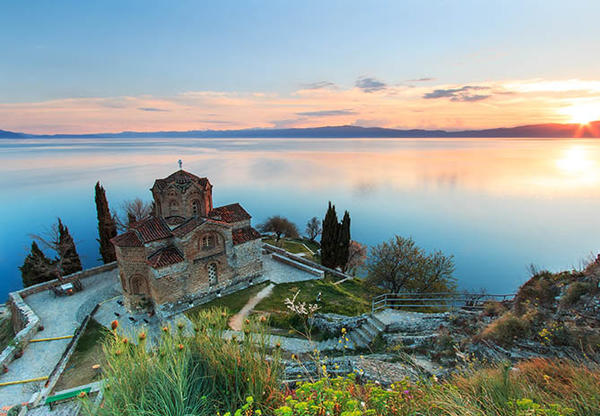
Alongside the border between the Republic of Macedonia and the Republic of Albania, extends Ohrid – lake, town and symbol of the region’s long and rich history. The only Macedonian cultural and nature monument enumerated on the UNESCO Heritage List since 1979, is unusual in that they are on both lists - cultural and natural heritage - because of the exceptional universal value of the beautiful natural reserve and the masterpiece of human creative genius.
Ohrid Lake, the deepest lake in the Balkans and one of the deepest and oldest lakes in Europe. This unique aquatic ecosystem accommodates more than two hundred endemic species. It is thought to have originated five million years ago. For comparison, the age of most other lakes is less than 100,000 years old. The incredible longevity of Ohrid Lake can be seen through the prism of resistance to ecosystem changes. Remarkably, exotic species do not seem to pose a threat to Ohrid Lake. Endemic species have adapted so well that new species did not disturb the existing balance.
The city of Ohrid - the center of the ancient civilization and the important Roman crossroads on the famous Via Egnatia, a city-monument of grandiose archaeological discoveries, early Christian basilicas and numerous Orthodox churches, is rightly listed on the list of world cultural heritage. Ohrid is very important for the history, religion and culture of the Slavs, because the students of Cyril and Methodius - St. Clement and St. Naum - taught their followers the Cyrillic alphabet. At the end of the 9th century, Ohrid became the center of the spread of Christianity among Slovenes.
Ohrid Lake was a popular tourist destination in the former Yugoslavia, visited by over 200,000 tourists a year. However, turism figures fell rapidly due to the regional instability in the 1990s. The improved political situation has enabled tourists to rediscover the beautiful nature and crystal clear waters of the Ohrid Lake, ensuring that the local tourism scene has now recovered and represents again a significant share of the local economy.
Thousands of years before tourists would come to enjoy a weekend on the lakeside, the allure of Ohrid attracted settlers. The shores of the lake have been inhabited since the prehistory, and the oldest settlements date back to the Neolithic, about 6000 BC. The Macedonian side alone contains over 170 archaeological sites. Today the lake is surrounded by three major towns - Ohrid and Struga in Macedonia, and Podgradec in Albania.
The town of Ohrid is listed on the World Heritage List, regardless of the lake. It is of immense importance to Slavic history, religion and culture, because it is there that St. Clement and Naum created the Cyrillic script. Thanks to their efforts, the script was accepted in the Slovene countries, and this opened the door for the entry of Christianity into Eastern Europe. Thus, it would be correct to suggest that Ohrid is the birthplace of the literacy, education and religion of Orthodox Slavs. Saint Clement is celebrated as a protector of the city, while his two predecessors also from this region, Saint Cyril and Methodius, were declared co-patron saints of Europe together with Benedict of Nursia, by Pope John Paul II.
In the very center of Ohrid, lie the remains of the ancient Greek city of Lychnidos, which predated Alexander the Great. When the Bulgarians conquered the city, the name was changed to Ohrid. The town was the seat of the Bulgarian Patriarchate in the late 10th century and later it often passed into the hands of Byzantium and Serbia. Finally, the city was conquered by Ottomans and remained in their possession until 1913, when control was taken over by the Serbian army.
According to the famous 17th-century legend about Ohrid, it was once home to 365 churches - one for each day of the year. Today there are far fewer, the most important of which are the Church of Saint Sophia, the Monastery of Saint Naum and Saint Panteleimon Monastery. All three are believed to have been built in the 9th and 10th centuries and were important educational facilities. In Saint Panteleimon Monastery, his builder, Saint Clement, taught Cyrillic. Moreover, in the Church of Saint Sophia are preserved frescoes dating to the 11th century and they are widely considered as among the most significant achievements of Byzantine painting.
So whether you are looking for a relaxing break in the surroundings of untouched nature of one of the oldest European lakes, or a holiday where you will explore the history and tradition of the Balkans, Ohrid certainly has much to offer.
Source: Elevate - The inflight magazine of Air Serbia, October 2014
Text: Stefan Kondić